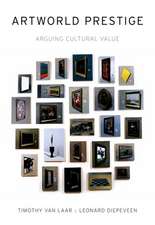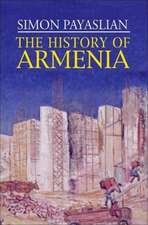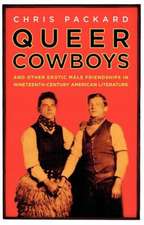Making Settler Cinemas: Film and Colonial Encounters in the United States, Australia, and New Zealand
Autor P. Limbricken Limba Engleză Hardback – 21 iul 2010
| Toate formatele și edițiile | Preț | Express |
|---|---|---|
| Paperback (1) | 384.86 lei 6-8 săpt. | |
| Palgrave Macmillan US – 21 iul 2010 | 384.86 lei 6-8 săpt. | |
| Hardback (1) | 388.72 lei 6-8 săpt. | |
| Palgrave Macmillan US – 21 iul 2010 | 388.72 lei 6-8 săpt. |
Preț: 388.72 lei
Nou
Puncte Express: 583
Preț estimativ în valută:
74.39€ • 76.85$ • 61.91£
74.39€ • 76.85$ • 61.91£
Carte tipărită la comandă
Livrare economică 25 martie-08 aprilie
Preluare comenzi: 021 569.72.76
Specificații
ISBN-13: 9780230102644
ISBN-10: 0230102646
Pagini: 288
Ilustrații: XV, 272 p.
Dimensiuni: 140 x 216 x 15 mm
Greutate: 0.43 kg
Ediția:2010
Editura: Palgrave Macmillan US
Colecția Palgrave Macmillan
Locul publicării:New York, United States
ISBN-10: 0230102646
Pagini: 288
Ilustrații: XV, 272 p.
Dimensiuni: 140 x 216 x 15 mm
Greutate: 0.43 kg
Ediția:2010
Editura: Palgrave Macmillan US
Colecția Palgrave Macmillan
Locul publicării:New York, United States
Cuprins
Introduction PART I: Making a Settler Cinema in the United States Playing Empire: Settler Masculinities, Adventure, and The Four Feathers (1929) Imperial Production, Settler Colonialism, and the Argosy Westerns PART II: Empire and Settler Cinema in Australia Ealing's Australian Westerns PART III: Film History and Settler Cinema in Aotearoa/New Zealand Hei Tiki (1935): Film Histories Past and Present Unsettled Histories: The Seekers (1954)
Recenzii
"Making Settler Cinemas is refreshing and lively, providing a substantial model for cross-cultural flm studies." - Screening the Past
'Focusing on the relationships or 'encounters' among British and U.S. imperial designs, postcolonial settler societies, indigenous cultures, and film production and reception in the titular areas from 1929 to 1954, Limbrick examines how ostensibly localized cultural practices exist within eminently geopolitical, networked spaces of exchange and friction. Beautifully researched and lucidly written, this book has the benefit of being both timely and also enduring as an historical analysis of a nexus of crucial, formative encounters, whose influence on politics and culture continue to be felt today.' Janet Walker, Professor of Film and Media Studies, UC Santa Barbara
'This far-reaching and breathtakingly layered analysis reconstructs complex circuits of film production enabled by settler colonialism, connecting the societies of Australia and New Zealand to the empires of Britain and the United States. After reading Limbrick on the production and screening of The Seekers among the Maori in New Zealand, it will be impossible to look at American Westerns in the same way. This book uncovers for the first time routes taken by film directors, crews and texts across empires, settler colonies and indigenous populations, making it a must-read for those interested in colonial and transnational cinemas, media industry, global indigenous media, reception and ethnographic studies. A model of innovative historiography.' Priya Jaikumar, author of Cinema at the End of Empire: A Politics of Transition in Britain and India
'Limbrick has produced a rigorously transnational film history that demonstrates the cultural and economic interdependencies of colonies and colonizers and of the media industries produced by such geopolitical relations. After Making Settler Cinemas, we no longer can consider American cinema, or British, or that of any other country simply in national terms. Instead, Limbrick shows us how to think of films from the classical period as international commodities, and demonstrates the necessity of combining textual, archival, and ethnographic research in our studies of the cinema.' Eric Smoodin, Professor, Film Studies and American Studies, UC Davis and author of Regarding Frank Capra: Audience, Celebrity, and American Film Studies, 1930-1960
'Meticulously researched and engagingly presented, Limbrick¹s study provides a much-needed investigation of filmmaking practices in the settler colonial societies of the United States, Australia and New Zealand. Focusing on the period 1929 -1954, Making Settler Cinemas offers a map of the transnational trafficking that conditioned the creation of films such as Merian C. Cooper's The Four Feathers, the Australian Westerns produced by Britain's Ealing Studios, and British and American films made in New Zealand. Drawing together archivalmaterials, close textual analysis and discussions of contemporary exhibition practices, Limbrick presents a range of voices and practices that dramatize the multiple, conflicting and charged encounters between indigenes, settlers and transnational cultural producers. Limbrick's innovative study not only brings overdue attention to the specificities of settler colonialism and its encounters with indigenous and imperial cultural forces but offers a rich tool box for revisiting those films hitherto narrowly understood under the banner of the national. Timely and original, Making Settler Cinemas is sure to be a significant and lasting contribution to the fields of film studies and postcolonial studies.' Jo Smith, Senior Lecturer, Media Studies Programme, School of English, Film, Theatre, and Media Studies, Victoria University of Wellington
'Focusing on the relationships or 'encounters' among British and U.S. imperial designs, postcolonial settler societies, indigenous cultures, and film production and reception in the titular areas from 1929 to 1954, Limbrick examines how ostensibly localized cultural practices exist within eminently geopolitical, networked spaces of exchange and friction. Beautifully researched and lucidly written, this book has the benefit of being both timely and also enduring as an historical analysis of a nexus of crucial, formative encounters, whose influence on politics and culture continue to be felt today.' Janet Walker, Professor of Film and Media Studies, UC Santa Barbara
'This far-reaching and breathtakingly layered analysis reconstructs complex circuits of film production enabled by settler colonialism, connecting the societies of Australia and New Zealand to the empires of Britain and the United States. After reading Limbrick on the production and screening of The Seekers among the Maori in New Zealand, it will be impossible to look at American Westerns in the same way. This book uncovers for the first time routes taken by film directors, crews and texts across empires, settler colonies and indigenous populations, making it a must-read for those interested in colonial and transnational cinemas, media industry, global indigenous media, reception and ethnographic studies. A model of innovative historiography.' Priya Jaikumar, author of Cinema at the End of Empire: A Politics of Transition in Britain and India
'Limbrick has produced a rigorously transnational film history that demonstrates the cultural and economic interdependencies of colonies and colonizers and of the media industries produced by such geopolitical relations. After Making Settler Cinemas, we no longer can consider American cinema, or British, or that of any other country simply in national terms. Instead, Limbrick shows us how to think of films from the classical period as international commodities, and demonstrates the necessity of combining textual, archival, and ethnographic research in our studies of the cinema.' Eric Smoodin, Professor, Film Studies and American Studies, UC Davis and author of Regarding Frank Capra: Audience, Celebrity, and American Film Studies, 1930-1960
'Meticulously researched and engagingly presented, Limbrick¹s study provides a much-needed investigation of filmmaking practices in the settler colonial societies of the United States, Australia and New Zealand. Focusing on the period 1929 -1954, Making Settler Cinemas offers a map of the transnational trafficking that conditioned the creation of films such as Merian C. Cooper's The Four Feathers, the Australian Westerns produced by Britain's Ealing Studios, and British and American films made in New Zealand. Drawing together archivalmaterials, close textual analysis and discussions of contemporary exhibition practices, Limbrick presents a range of voices and practices that dramatize the multiple, conflicting and charged encounters between indigenes, settlers and transnational cultural producers. Limbrick's innovative study not only brings overdue attention to the specificities of settler colonialism and its encounters with indigenous and imperial cultural forces but offers a rich tool box for revisiting those films hitherto narrowly understood under the banner of the national. Timely and original, Making Settler Cinemas is sure to be a significant and lasting contribution to the fields of film studies and postcolonial studies.' Jo Smith, Senior Lecturer, Media Studies Programme, School of English, Film, Theatre, and Media Studies, Victoria University of Wellington
Notă biografică
PETER LIMBRICK is Assistant Professor in Film and Digital Media at the University of California, Santa Cruz, USA where he teaches international cinemas. His publications have appeared in Screening the Past, Cinema Journal, Camera Obscura, and Journal of Visual Culture.














